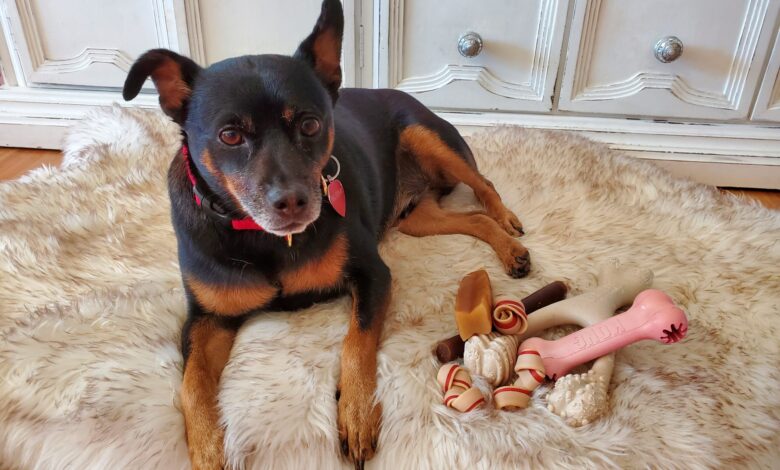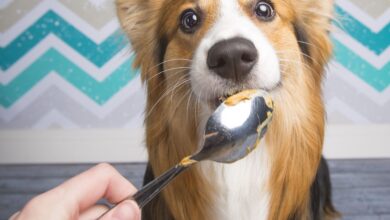Guide to Today’s Dog Chews – Dogster

Chewing is as natural to dogs as wagging their tail when they are happy or barking when they hear your keys in the front door. Unfortunately, dogs’ instincts to chew can quickly turn them into a “bad dog” if they decide to chew on the wrong item, such as your table leg or your favorite shoe. Luckily, dog chew products can help redirect your dog’s natural desire to chew into something positive.
With so many options available, picking the best dog chews for your pup can be confusing. This guide helps you understand why your dog chews, what types of dog chews are available and your dog’s style of chewing. With this knowledge, you can pick a chew your dog enjoys while also considering safety, durability and other needs, such as dental health.
Why do dogs chew?
To figure out which chew is best for your dog, you must understand why your dog wants to chew. Chewing can be a very positive activity for your dog and helps a dog express the following:
- Teething: Puppies chew to relieve the pain from their permanent teeth coming in through their gums. Puppies start losing their baby teeth at around 3 months of age, and all baby teeth fall out at around 6 months of age. Just like with humans, this can be painful. Chewing helps to relieve the discomfort.
- Investigation: Dogs use their mouth to investigate the world. According to Colin Tennant, the chairman of the U.K. Canine and Feline Behaviour Association, “Chewing, for a dog, is like a human opening a door and looking into a room. People are nosy, and so are the dogs. But they investigate with their mouths because they don’t have hands.” Texture and taste are particularly appealing to a dog. Colin also says that, “Dogs frequently chew things because they like the taste or the odor. In a home, the odors that the dogs find the most attractive are the human odors.”
- Anxiety: Chewing is a coping mechanism for dogs when something in their environment has changed, such as recently moving, new furniture, a new family member or even being left at home.
- Enjoyment: Some dogs chew just because they enjoy chewing. It fulfills both a physical and mental health need for a canine, and their chewing on the right items can be a positive experience for them.
8 types of dog chews
Many different types of dog chews exist. Factors to consider include digestibility, durability, intended purpose and composition.
- Indigestible chews: These are typically nylon or hard plastic, making them a long-lasting dog chew. Unfortunately, these are not digestible for a dog. If a dog eats it, the material may cause gastrointestinal (GI) blockage that may require surgery. These chews are typically very hard and can damage a canine’s teeth. The sharp edges of the plastic or nylon can also hurt a pup’s gums. Examples:
- Rawhide chews: These are dried animal skins made from the leftovers of the leather industry. Rawhide is the inner skin layer of cow, horse and pork hides, and is separated at the slaughterhouse. Rawhide is not digestible, so it can lead to GI blockages. Also, the skins in these chews are often treated with chemicals to preserve them, which may cause an upset stomach or allergic reaction. Look for Rawhide manufactured in the U.S. Examples are:
- Bully sticks: These are a single-ingredient, longer-lasting dog chew that is highly digestible and made from beef pizzle (pizzle means penis). These sticks come in various sizes, shapes and flavors. Unfortunately, these sticks can carry a distinct odor that some pet owners do not find appealing. Some brands offer low-odor varieties.
- Chewy Bones & Chews Made in USA Curly Bully Stick
- Nebraska Crunchy Steer Sticks for Dogs from Sancho & Lola’s Closet
- Dental chews: One of the benefits of dog chews, no matter what type you select, is that they help to keep your dog’s teeth clean and prevent tartar and plaque buildup. Dental chews are designed specifically for a dog’s dental health and are digestible. The downside is they don’t last very long, especially for more aggressive chewers. Examples are:
- Body parts: These all-natural dog chews bring out your pup’s natural instincts. Body parts include bones, pig ears, hooves, tracheas, feet, tails and even pig snouts. They typically are longer lasting than non-natural chews. However, certain body parts, such as ears, can be higher in fat, so they are not suitable for canines who require a low-fat diet. Examples are:
- Yak chews: These are long-lasting, all-natural, preservative-free digestible chews that are made from milk, salt and lime juice. They are baked to make a hardened cheese that is shaped into sticks. Yak chews are great for the more aggressive chewers. They are hard, so some dogs don’t prefer them. Examples are:
- Antlers: Animals such as deer, elk and moose naturally shed their antlers in the wild. These chews are the discharged antlers. Antler dog chews can vary in size and toughness depending on the type of antler and how they are cut. If pieces break off and are eaten, they can cause GI upset. Examples are:
- Easy-to-digest chews: These are short-lasting chews that your dog can digest, making these among the safest dog chews. (You still need to supervise your dog in case he gets pieces stuck in his teeth, like some chewy items get stuck in human teeth.) Many are called rawhide alternatives and are made of fish, meat and/or vegetables among other things. They meet your dog’s need to chew and help maintain healthy teeth. Some are also vitamin and mineral enriched. Examples are:
Selecting the right chew for your dog
Now that you know some reasons that dogs chew and some of the different types of chews available, you may already have an idea of the chews your dog would prefer. One final consideration is to determine what type of chewing style your dog has. Don’t just pick a dog chew that your pup enjoys; choose the safest dog chew based on the way your dog chews.
- The inhaler: These types of dogs take any type of chew as a real challenge to see how fast they can destroy it and swallow the pieces. Typically, they break a chew into large chunks and then eat those chunks almost whole. Digestible chews are best for inhalers.
- The demolisher: These dogs take a new chew and quickly determine the fastest way to destroy it, but they usually don’t eat the pieces. They just enjoy the challenge of seeing how fast they can destroy the chew or toy.
- The power chewer: These dogs need a chew that stands up to their strong jaws or chewing excitement. They may not necessarily want to destroy the chew, but they need a chew that can stand up to heavy chewing. Look for chews made specifically for strong chewers.
- The nibbler: These types of dogs typically care for their chews and toys and take their time enjoying the chew.
- The puppy: Puppies either have baby teeth or their permanent teeth are just coming in, so they need a soft and gentle chew that won’t hurt or break their teeth. There are chews made specifically for puppies.
- The senior: A senior dog may still really enjoy chewing but also needs a softer, more forgiving chew. Their older teeth and gums may be more prone to breakage or cuts. There are chews made specifically for seniors.
Dog chew safety
No matter what dog chew you pick, supervise your dog with a chew in case they gag or choke on the item. Always check the chew each time before giving it to them for any damage or wear and tear. If the chew becomes too small (small enough for your dog to swallow it whole), take it from your dog immediately and promptly dispose of it. Also, don’t leave dog chews out in the sun or extreme temperature. No matter what type of material it is, high temperatures can degrade and weaken the chews and make them susceptible to breaking or tearing.
Now that you know why your dog wants to chew, what type of dog chew products are available, and how to match that up with the chew style of your dog, you can confidently pick the best dog chews for your pup. This keeps your dog from becoming the “bad dog” that chews up ’the wrong things.
Source link






